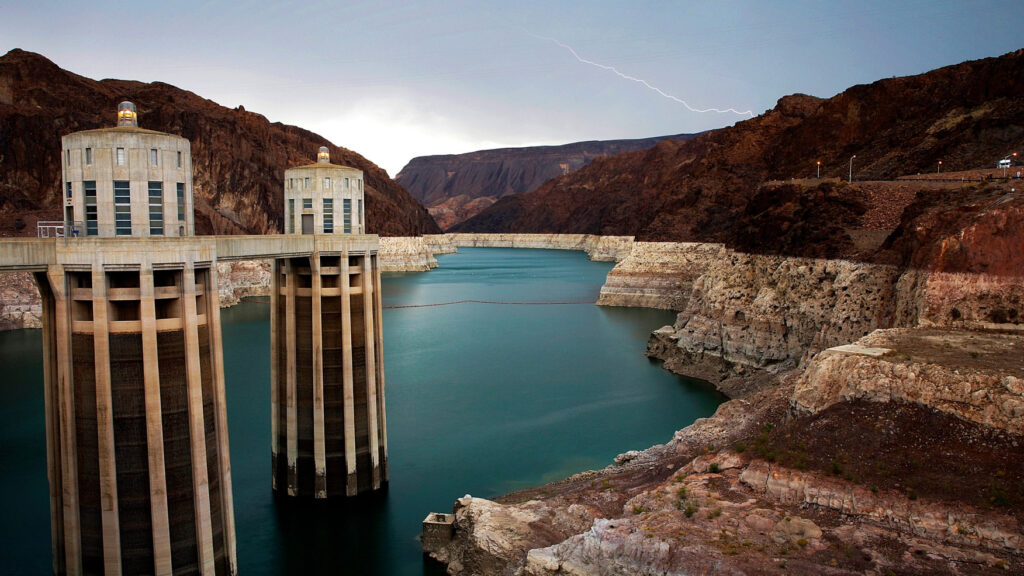Table of Contents
Where Does Las Vegas Get its Water?
When you live in the desert water is a very important part of survival. The Colorado River that runs South into Lake Mead is where Las Vegas gets its most precious resource, water. Without it, Las Vegas would not survive very long.
Projections Show Lake Mead Dropping Far Below Government’s ‘Shortage’ Level
Bureau of Reclamation projections contained in a 24-month study indicate the lake could fall another 30 feet by November 2022.
The agency monitors the lake level and makes decisions on how to allocate river water. Measurements and projections that are released in August will determine if a Level 1 shortage would be declared. That would trigger automatic cuts in water allocations.

It’s estimated that Vegas gets up to 90 percent of its water from Lake Mead, courtesy of the mighty Colorado River. It stretches from its snowmelt source in the Rocky Mountains and winds its way through seven US states including Nevada, before eventually arriving at its mouth in Mexico’s Gulf of California.
By comparison, the remaining 10 percent or so of Sin City’s water supply trickles in from groundwater wells and other pipelines.
That’s a lot of over-reliance on a source that serves around 20 million people across a number of states. Especially since, despite its population growth over the years, Nevada’s share of Lake Mead’s supply is historically much less than neighboring California and Arizona.
Las Vegas Relies on The Colorado River
From the Colorado River, the water reaches man-made Lake Mead via Lake Powell and is sucked through Las Vegas Valley’s “straws” on a journey that carries the water thousands of miles through treatment facilities on a cyclical mission.
It returns to Lake Mead by way of the Las Vegas Wash and finally enters the water system to get to Sin City’s taps.
When it’s flushed back into the sewer system, it resumes its journey from the treatment plant to wash to the lake and back again into homes and businesses.
According to a state official, it has reached a “critical mass” of its water supply, leaving the state to figure out how it will supply enough water for its growing population.
Is Las Vegas Running Out Of Water?

But if Vegas’s main water supply is reused and recycled constantly, why is the city said to be running out of water?
Simply put, it’s an issue of supply and demand and… climate.
Not all the water is flushed or drained back into the system for re-use.
Instead, gallons of the good stuff is wasted outdoors, for example, through automatic sprinkler systems.
One report suggests that Vegas gets through more water than most US cities, supping up or hosing out around 219 gallons per person on an average day.
Coupled with the very real impact of climate change and the desert setting, it all makes for a potent mix.
So federal government officials are tipping Lake Mead levels to finally fall below 1,075 feet in 2021.
Las Vegas Water Supply Drying Up?
The huge reservoir has already plummeted by 130 feet since 2000 and the projection means Nevada, along with other states like California and Arizona, could have access to much less water.
But it’s not necessarily Sin City’s fault.
It is, after all, much harder to conserve water in the middle of a desert than in a city soaked with rain.
Nevada ranked No. 3 in U.S. News’ 2019 Best States rankings for net migration from 2014 to 2017. The state’s population increased by approximately 2.1% from 2017 to 2018, according to the U.S. Census Bureau.
Nevada Seek Options for Water Conservation
As Nevada looks at different options to lessen its water shortage, the legality of different solutions is up in the air. In August 2018, the state’s top water regulator has denied Southern Nevada Water Authority to bring water to Las Vegas through a pipeline in eastern Nevada.
There also is a possibility of striking a deal with California in which Nevada would finance a desalination facility for the Golden State’s use off the coast of California or the Pacific coast of Mexico. In exchange, Nevada would gain California’s share of the Colorado River, which accounts for 90% of Las Vegas Valley’s water supply.
Nevada isn’t the only state facing water scarcity. The World Resources Institute identified New Mexico as the state with the highest strains on its water availability, followed by California, Arizona, Colorado and Nebraska.
Will Lake Mead Ever Fill Up Again?

Despite The Headlines, it’s Not All Bad News for Nevadas Water Crisis
Some even hail the area for its water smarts, with the LV community using 27 billion gallons less water in 2018 than it did just after the Millennium.
In the last 20 years, the city has placed restrictions on new sod and yard watering, while the Southern Nevada Water Authority (SNWA) has spent millions on a pumping station project to increase capacity.
But crucially, this water will not come from Lake Mead; it’s there as a backup while hopes rest on the main reservoir to recover and resist.
Southern Nevada is no stranger to water warnings, either.
There were previous predictions that the region would run out of water by 1995 too before swift action was taken.
Water usage restrictions and investment in technology, such as thousands of leak monitors, as well as implementing fines for water violations, have resulted in resilience so far.